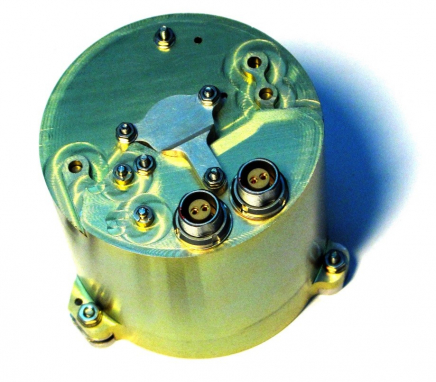-
StatusCompleted
-
Status date2015-10-16
-
Activity Code4E.016
The objective of the current activity is to design, analyse, manufacture and test an Engineering Model of a Non-Explosive Actuator (NEXA), to be used in Hold-Down and Release Mechanisms (HDRM) of future telecom platforms.
The Technology Readiness Level (TRL) target at the start of the activity is TRL 5 (i.e. prototype demonstration in relevant environment).

NEXA mechanism (Credit: Spin.Works, S.A.)
The scope of activities for the NEXA mechanism is performed under a joint EM/QM approach. The mechanism is developed as a qualification model (QM) up to DDR, while the production, assembly and testing are carried on an engineering model (EM).
Four critical parameters for the development of the mechanism are identified:
- Reliability, self-generated release shock, reusability and release time (repeatability and simultaneity). These parameters guide the development of NEXA. From the start of the project, three features are identified as highly desirable: ultra-low self-generated shock and reusability. The incorporation of these features poses a challenge for the design of the mechanism.
Also of great concern during the development process is the need to conservatively avoid any pre-existing intellectual property rights. A large number of existing patents in the field has been analysed in order to steer the development process away from previously patented concepts, and ensure patentability of the concept developed in the context of this activity. This adds additional constraints on the design space to an ambitious fast-acting ultra-low-shock reusable design.
NEXA is a fast-acting, fully re-usable, ultra-low shock HDRM, enabling a discrete point separation.
Self-generated release shock
HDRM are characterized with respect to their self-generated Shock Response Spectrum (SRS) peak: NEXA releases Ultra-Low Shock during its operation.
Re-usability & Resettability
Assembly, Integration and test (AIT) procedures require multiple HDRM releases, and are greatly simplified when re-usable HDRM are employed. The re-usability of an HDRM is thus a key feature with respect to its implementation in space systems. NEXA is fully reusable (i.e., resettable); Furthermore, its operation requires access from only one side of the mechanism (the HDPA bolt side, the same side used to torque the HDPA bolt).
Release Time (Repeatability & Simultaneity)
Time-critical releases and multi point simultaneous releases require reliable and repeatable releases, with minimal scattering (dispersion) of individual release times, even for HDRMs at different temperature. NEXA is a fast-acting mechanism with low actuation time scatter
NEXA releases Ultra-Low Shock during its operation:
- The Shock Response Spectrum (SRS) peaks are 163 g, 73 g and 72 g for axial, horizontal and vertical directions, respectively, during a 25 kN preload release.
NEXA is easy to use:
- The mechanism is fully reusable (i.e., resettable). Its operation requires access from only one side of the mechanism (the HDPA bolt side, the same side used to torque the HDPA bolt). Mechanism reset is performed by one operator in less than a minute.
NEXA is a fast-acting mechanism with low actuation time scatter:
- Total actuation time is between 69 ms and 236 ms (corresponding to the extremes of the tested temperature range: 86 ºC / -73 ºC)
- At ambient conditions the mechanism’s average total actuation time is 64 ms, with a maximum measured scatter of 24 ms.
NEXA uses standard pyrotechnic electric signals (26V-40V, 4.1A 30ms pulse nominal). Its dimensions are approximately 62mm diameter per 60mm height, and it weighs 306g.
SYSTEM ARCHITECTURE
The NEXA mechanism is a discrete point separation device of generic type, i.e. independent from any specific application. Its design is scalable in order to widen as much as possible the range of potential applications and preloads.
NEXA’s functionality is provided by five basic elements:
|
Force Magnitude |
Elements |
Description |
|
Initiator |
Converts electrical energy from the release actuation pulse into mechanical energy usable by the latch elements. |
|
|
Latch |
Maintains the HDRA in the secured configuration; up to reception of the release actuation signal by the Initiator. |
|
|
Force |
Effective force reduction elements are crucial for reliable synchronous ultra-low shock HDRA designs. These provide the necessary leverage and load-uncoupling, between the high forces present at the hold-down preload assembly (HDPA) and the coupling elements, down to the low-energy initiator at the latch. |
|
|
Preload |
Mechanical elements that reduce the HDPA preload immediately before releasing the HDPA bolt member. This feature is not effective in all existing HDRA, but NEXA includes it in its design in order to reduce the self-generated shock during release. |
|
|
Coupling |
Mechanical elements that interface and secure the HDPA bolt, or an adaptor on the HDPA. |
NEXA elements.
The force reduction elements form the backbone of NEXA, and are based in Euler (capstan) friction provided by a cable which wraps around a cylindrical body while constraining the coupling elements. In conjunction with the used coupling elements, this provides the required load uncoupling and provides a very effective preload relief function.
The high force reduction achieved enables the use of low mass and volume SMA initiator, while maintaining the electrical requirements of existing pyro lines (current, voltage and pulse times).
All the planned milestones of the project are completed: Preliminary design review (PDR), detailed design review (DDR), test readiness review (TRR) and the post-test review (PTR).
The scope of activities for the NEXA mechanism is performed under a joint EM/QM approach. The mechanism is developed as a qualification model (QM) up to DDR, while the production, assembly and testing are carried on an engineering model (EM).
As part of the activity’s initially planned tasks, an implementation plan is defined, laying forth the future activities required for the completion of:
- Successful qualification testing of a QM.
- Development up to a commercially available product and the delivery of a FM
A QM/EM NEXA mechanism has been designed, manufactured and tested in representative conditions. In its final configuration, the mechanism performed successfully in all the planned tests. The mechanism is developed as a qualification model (QM) up to DDR, and the production, assembly and testing are carried on an engineering model (EM).
A fast-acting, fully re-usable, ultra-low shock HDRM is a somewhat demanding mechanism to design. During the course of the present activity setbacks had to be overcome in order to refine the function of the mechanism and bring it to a TRL of 4-5, with a severe impact on project schedule.
Non-conformances arose from the underestimated effect of intra-filament friction in the resulting elastic properties of a multifilament cable. The elastic snapback of the cable has an impact on the function of the mechanism, and found to be lower than predicted at DDR. This increases the operator force necessary for the reset function of the mechanism. The built-to-spec multi-stranded cable configuration was abandoned in favor of a COTS wire rope cable, with flawless operation and successful testing afterwards.



